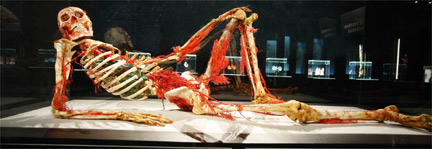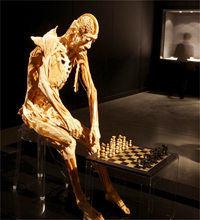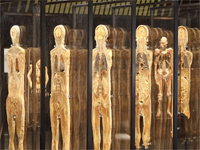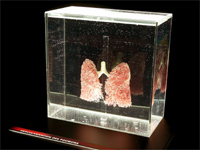The Anatomy of Controversy in Paris
by Alison Hird
Article published on the 2009-03-02 Latest update 2009-04-22 09:42 TU
Culture in France: Controversy over Our Body
A corpse sits pontificating in front of a chess board, reminiscent of Rodin’s Le Penseur, another strikes an athletic pose and memories of the Bionic man come to mind. Close by, the man whose arm and leg muscles have been cut away from the bone and flayed out to look like feathers gets you thinking Icarus and tales of flying that bit too near the sun. When we reach the two cm thick head-to-toe slices of human body, I had to push away thoughts of beautiful pieces of walnut.
You have to keep pinching yourself to remember the 20 specimens in the recently-opened “Our body, à corps ouvert” exhibition were once walking, talking and perhaps playing chess like you or I. It’s both a strong point and a source of polemic here in France. A strong point because for the first time visitors can see what has previously been the reserve of forensic scientists. And it’s fascinating says exhibition-organiser Pascal Bernardin as he shows me the complexities of our chess player’s spinal cord. “You can spend half an hour just staring at this. The human body is a beautiful machine”.
In addition to bodies in various everyday poses, some 250 body parts, including organs like the brain, heart and lungs are displayed in glass cases like museum pieces. Healthy lung specimens for example, are placed next to unhealthy ones. In one case two placentas are side by side – one showing the outer ivory-coloured sack, the other only the plethora of red arteries interspersed with a few blue veins: it looks like a fine piece of orange coral.
All the specimens have a plastic sheen to them, thanks to the technique developed by Gunther von Hagens called polymer impregnation. It involves replacing body fluids with reactive plastics that prevent decay and decomposition, while the organs, muscles and nerves are maintained down to the microscopic level.
The bodies look more like very life-like sculptures than corpses, making them a lot easier on the eye, and conscience. And yet humans they are. Chinese to be precise. While their exact identity has not been disclosed, Bernardin says he has no reason to doubt the assurances given by the Anatomical Sciences and Technologies Foundation in Hong Kong who designed the exhibition. “There are 200,000 surgeons in China… Just like in Europe they study the art of dissection. And thousands of people dontate their bodies through hospitals so the medicine world can study. We’ve got all the proof that everything was done legally.”
Yet many French scientists were not convinced and Bernardin struggled to find a venue in Paris. Both the Cité des Sciences and Musée de l’Homme were deterred by a report by the National Ethics Committee which concluded the exhibition was not scientific enough and encouraged voyeurism.
As Vice-president Pierre le Coz told Rue89 online newspaper bodies can only be used after death for scientific purposes, even if the people gave their consent. “When you consider the way China respects human rights, what can consent mean? We would never used French bodies like that,” le Coz explains.
In the end the enterprising Bernardin hired his own venue, Espace Madeleine 12, for the four-month run. He says it’s doing well, attracting 12,000 visitors per week since it opened on February 12th, but the polemic continues. A group of scientists led by Francois Rastier, a research director with the CNRS centre for scientific research, has launched a petition calling for the exhibition to be suspended until more is known about the origin of the bodies.
As well as the doubt over consent, he accuses the exhibition of using the corpses for commercial and showbizz-driven rather than scientific purposes. Pascal Bernardin is firm in his defence, pointing to the primarily educational nature of the exhibition (all exhibits are accompanied by panels with simple but accurate scientific explanations) and insisting that while it's aesthetic in its approach, it has nothing to do with art.
He also claims there’s a double standard operating, citing precedents such as the Musée de l’homme which has a body on display dating from 1875 and Musée Veterinaire de Fragonard near Paris which also displays a flayed body dating from the late 18th century. Not to mention the mummies at Le Louvre… “If this can be shown to the public why can’t you show a real exhibition which at least gives you the opportunity to see how the body works. You see bodies and organs everywhere but not prepared with this same talent or techniques. I think there is some hypocrisy in saying 'what the hell is this guy doing when it’s all around us'.”
He’s proud to point out the exhibition is linked to the campaign for organ donation by Marie Berry, this year’s national medical cause in France. “I think at the end of the day if we can help all those organisations asking for organ donation we will prove that it was the right thing to do.”
In the meantime, despite the hefty 15-euro entry fee, visitors are pouring in, the vast majority clearly unperturbed by the polemic and relishing the opportunity to take a good look inside themselves.
Our body, à corps ouvert is at the Espace 12 Madeleine, 12 boulevard de la Madeleine until 10 May.
Culture
Cracking skulls!
2010-02-15 12:35 TU
France's gothic avant-garde
2010-02-13 15:16 TU
Winter sounds warm up French jazz fans
A tribute to trumpeter Don Cherry at a Free Jazz showcase festival outside of Paris.
2010-01-31 11:55 TU
Trance on a trapeze
2010-01-30 12:41 TU
Retro Mobile - classic car exhibition
260,500 euros for rusty old car found at bottom of lake
A rusty old Bugatti, which spent years at the bottom of a Swiss lake, sold for 260,500 euros at the Retro Mobile classic car exhibition on Saturday. Other more lovingly-restored pristine examples are exciting enthusiasts from across the world in a special anniversary event at Porte de Versailles in Paris.
2010-01-23 20:21 TU
France's changing face looks east
2010-01-22 16:17 TU
Putting art on film
2010-01-20 13:09 TU
What sex is a coffee bean, where does the aubergine come from?
2010-01-08 16:08 TU
Cocteau Twin flying solo
2010-01-06 16:43 TU
A taste of Nordic filmmaking in Paris
Ciné Nordica 2009 at Paris’s Panthéon cinema showcases filmmaking from Scandinavia. So what makes Nordic film different from the rest?
2009-12-22 17:15 TU



















